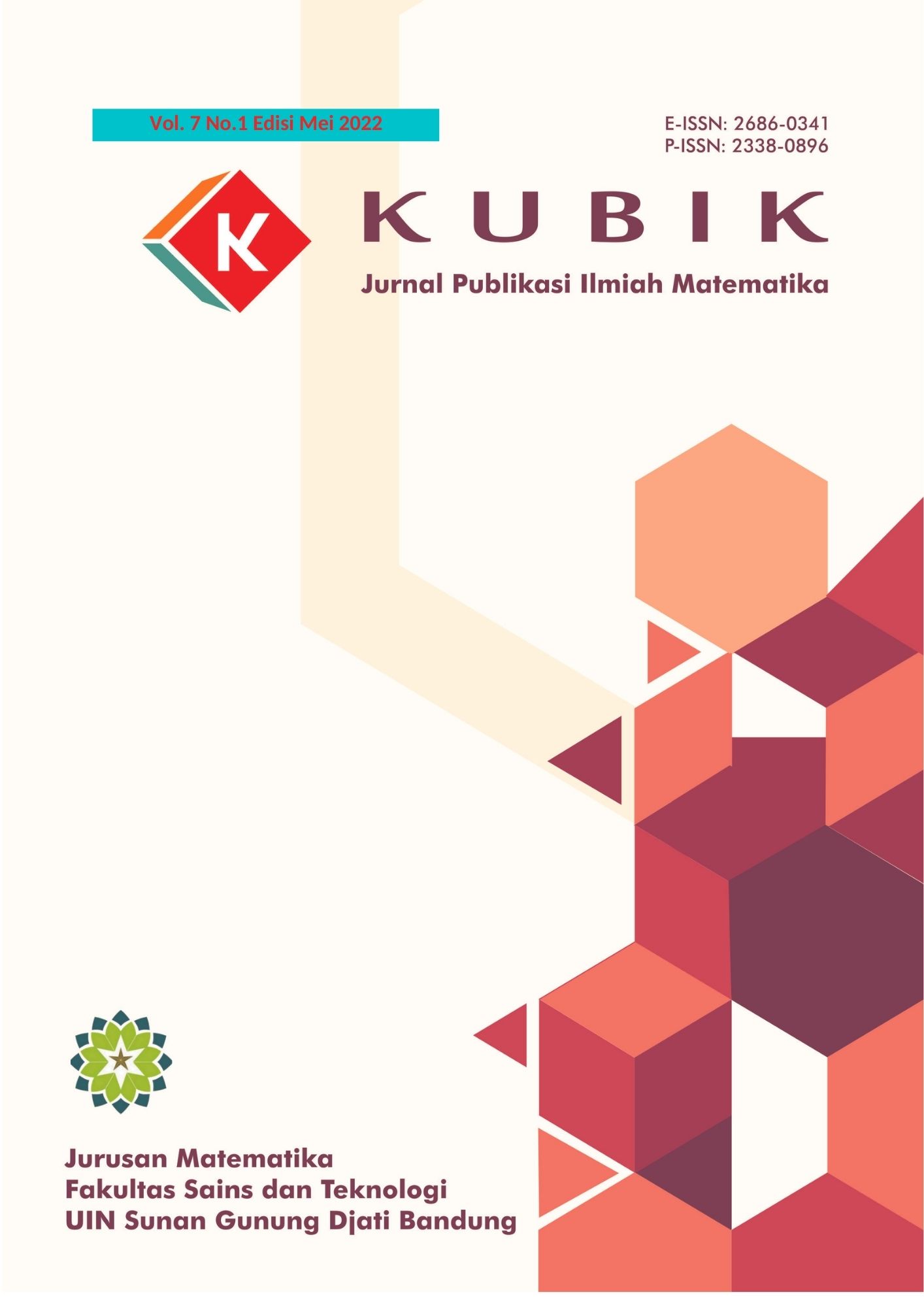The Optimization Problem of Batik Cloth Production with Fuzzy Multi-Objective Linear Programming and Application of Branch and Bound Method
DOI:
https://doi.org/10.15575/kubik.v7i1.18432Keywords:
Branch and bound, fuzzy linear programming, linear programming, multi-objective linear programming, optimizationAbstract
This study discussed fuzzy multi-objective linear programming (FMOLP) and its application. This research was conducted in Rumah Batik Mentari Jambi, which produces five batik motifs typical of the Jambi. In this research, the tolerance for additional raw material capacity is included in the model. This research aims to find out the number of tolerances needed, the maximum number of batik needed to be produced, and the minimum production time so that the producer can earn the maximum profit. The decision variables in FMOLP are the number of pieces of batik measuring in 2m2, which means the decision variables must be an integer. Therefore, after obtaining the optimal solution from FMOLP, then proceed with the branch and bound method to obtain the integer solution. The result of this research is that the addition of raw materials needed to earn optimal solutions is as much as 50% of the tolerance assumed in the model. Thus, owner can earn the optimal profit of Rp. 5,675,800.00/week by producing as many as 67 pieces of batik with the design of angso duo, 18 pieces with the design of gentala, and 50 pieces with the design of batang hari, and the minimum production time is 270 hours/week.
References
J. Kaur and A. Kumar, An Introduction to Fuzzy Linear Programming Problems. Switzerland: Springer, 2016.
S. H. Nasseri and H. Zavieh, “A Multi-objective Method for Solving Fuzzy Linear Programming Based on Semi-infinite Model,†Fuzzy Inf. Eng., vol. 10, no. 1, pp. 91–98, 2018, doi: 10.1080/16168658.2018.1509522.
E. S. Ammar and A. Emsimir, “A mathematical model for solving fuzzy integer linear programming problems with fully rough intervals,†Granul. Comput., vol. 6, no. 3, pp. 567–578, 2021, doi: 10.1007/s41066-020-00216-4.
W. Wang, Z. Du, and Z. Chen, “Fuzzy Multi-Objective Optimization for the Allocation of Multinational Production Resources Considering Import Quota,†in 2019 International Conference on Industrial Engineering and Systems Management (IESM), Sep. 2019, pp. 01–06. doi: 10.1109/IESM45758.2019.8948213.
G. K. Badhotiya, G. Soni, and M. L. Mittal, “Fuzzy multi-objective optimization for multi-site integrated production and distribution planning in two echelon supply chain,†Int. J. Adv. Manuf. Technol., vol. 102, no. 1–4, pp. 635–645, May 2019, doi: 10.1007/s00170-018-3204-2.
T.-S. Su, “A fuzzy multi-objective linear programming model for solving remanufacturing planning problems with multiple products and joint components,†Comput. Ind. Eng., vol. 110, pp. 242–254, Aug. 2017, doi: 10.1016/j.cie.2017.06.021.
E. Çakır and Z. Ulukan, “Fuzzy multi-objective decision making approach for nuclear power plant installation,†J. Intell. Fuzzy Syst., vol. 39, no. 5, pp. 6339–6350, Nov. 2020, doi: 10.3233/JIFS-189101.
A. Legiani, M. Y. Fajar, and E. Harahap, “Optimasi Produksi Sepatu Menggunakan Program Linier Multi Objective Fuzzy,†Pros. Mat. Unisba, vol. 2, no. 2, pp. 143–149, 2016, doi: http://dx.doi.org/10.29313/.v0i0.4585.
R. Erfianti and M. N. Muhaijir, “Optimasi Produksi Hijab Menggunakan Program Linear Multi Objective Fuzzy,†Jambura J. Math., vol. 2, no. 1, pp. 22–29, Dec. 2019, doi: 10.34312/jjom.v2i1.2406.
C. Li, “A fuzzy multi-objective linear programming with interval-typed triangular fuzzy numbers,†Open Math., vol. 17, no. 1, pp. 607–626, Jun. 2019, doi: 10.1515/math-2019-0048.
H. Suyitno, “Program Linier dengan Penerapannya,†2018, doi: 10.21776/ub.jsal.2018.005.02.1.
E. Kreyszig, Advanced Engineering Mathematics, 10th ed. Wiley, 2011.
F. S. Hillier and G. J. Lieberman, Introduction to Operations Reseach, Ninth edit. McGraw-Hill Education, 2010. doi: 10.2307/3008627.
Hamdy A. Taha, Operations Research: An Introduction. New Jersey: Pearson Prentice Hall, 2007.
D. G. Luenberger and Y. Ye, Linear and Nonlinear Programming,. Springer, 2015.
D. Rumita, Matriks Persamaan Linier dan Pemrograman Linier. Bandung: Rekayasa Sains, 2009.
U. Rafflesia and F. H. Widodo, Pemrograman Linier. Bengkulu: Badan Penerbitan Fakultas Pertanian UNIB, 2014.
Zimmerman, Fuzzy Set Theory and Its Applications, 2nd editions. Massachusstes: Kluwer Academic, 1991.
A. Wijaya, Pengantar Riset Operasi. Jakarta: Mitra Wacana Media, 2013.
R. Sekhon and R. Bloom, “Linear Programming - The Simplex Method,†Applied Finite Mathematics, 2021.
E. Safitri, S. Basriati, M. Soleh, and A. N. Rahma, “Penyelesaian Metode Quick Simplex Terhadap Metode Dua Fase dengan Dua Elemen secara Simultan pada Kasus Minimum,†KUBIK J. Publ. Ilm. Mat., vol. 6, no. 1, pp. 51–60, Aug. 2021, doi: 10.15575/kubik.v6i1.12259.
R. Ghanbari, K. Ghorbani-Moghadam, N. Mahdavi-Amiri, and B. De Baets, “Fuzzy linear programming problems: models and solutions,†Soft Comput., vol. 24, no. 13, pp. 10043–10073, Jul. 2020, doi: 10.1007/s00500-019-04519-w.
S. Kusumadewi and H. Purnomo, Aplikasi Logika Fuzzy Untuk Pendukung Keputusan. Yogyakarta: Graha Ilmu, 2013.
U. Sharma and S. Aggarwal, “Solving Fully Fuzzy Multi-objective Linear Programming Problem Using Nearest Interval Approximation of Fuzzy Number and Interval Programming,†Int. J. Fuzzy Syst., vol. 20, no. 2, pp. 488–499, Feb. 2018, doi: 10.1007/s40815-017-0336-8.
S. K. Singh and S. P. Yadav, “Intuitionistic fuzzy multi-objective linear programming problem with various membership functions,†Ann. Oper. Res., vol. 1, no. 2018, pp. 693–707, 2018, doi: 10.1007/s10479-017-2551-y.
K. Miettinen, Nonlinear Multiobjective Optimization. Boston: Kluwer Academic, 1999.
B. P. Cañedo, J. L. Verdegay, and R. M. Pérez, “An epsilon †constraint method for fully fuzzy multiobjective linear programming,†Int. J. Intell. Syst., vol. 4, no. 2020, pp. 600–624, 2020, doi: 10.1002/int.22219.
N. Van Hop, “Solving fully fuzzy multi-objective linear programming problem with fuzzy dominant degrees,†J. Intell. Fuzzy Syst., vol. 39, no. 3, pp. 3577–3595, Oct. 2020, doi: 10.3233/JIFS-191888.
G. Temelcan, H. G. Kocken, and I. Albayrak, “Finding compromise solutions for fully fuzzy multi-objective linear programming problems by using game theory approach,†J. Intell. Fuzzy Syst., vol. 42, no. 1, 2022, doi: 10.31289/jime.v2i1.2423.
J. Y. Dong and S. P. Wan, “A new method for solving fuzzy multi-objective linear programming problems,†Iran. J. Fuzzy Syst., vol. 16, no. 3, pp. 145–159, 2019, doi: 10.22111/IJFS.2019.4651.
M. Allahdadi and A. Batamiz, “Generation of some methods for solving interval multi-objective linear programming models,†OPSEARCH, vol. 58, no. 4, pp. 1077–1115, Dec. 2021, doi: 10.1007/s12597-021-00512-w.
G. Temelcan, I. Albayrak, H. Kocken, and M. Sivri, “Solving Fuzzy Multi-objective Linear Programming Problems Using Multi-player Zero-Sum Game,†in Intelligent and Fuzzy Techniques: Smart and Innovative Solutions, 2021, pp. 1483–1490. doi: 10.1007/978-3-030-51156-2_172.
Downloads
Published
How to Cite
Issue
Section
Citation Check
License
Authors who publish in KUBIK: Jurnal Publikasi Ilmiah Matematika agree to the following terms:
- Authors retain copyright and grant the journal right of first publication with the work simultaneously licensed under a Attribution-ShareAlike 4.0 International (CC BY-SA 4.0) License that allows others to share the work with an acknowledgment of the work's authorship and initial publication in this journal.
- Authors are able to enter into separate, additional contractual arrangements for the non-exclusive distribution of the journal's published version of the work (e.g., post it to an institutional repository or publish it in a book), with an acknowledgment of its initial publication in this journal.
- Authors are permitted and encouraged to post their work online (e.g., in institutional repositories or on their website) prior to and during the submission process, as it can lead to productive exchanges, as well as earlier and greater citation of published work (See The Effect of Open Access).
Â









